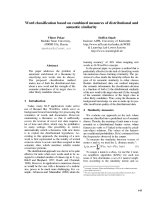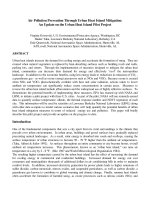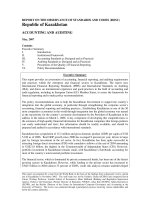RETINOBLASTOMA – AN UPDATE ON CLINICAL, GENETIC COUNSELING, EPIDEMIOLOGY AND MOLECULAR TUMOR doc
Bạn đang xem bản rút gọn của tài liệu. Xem và tải ngay bản đầy đủ của tài liệu tại đây (5.63 MB, 180 trang )
RETINOBLASTOMA –
AN UPDATE ON CLINICAL,
GENETIC COUNSELING,
EPIDEMIOLOGY AND
MOLECULAR TUMOR
BIOLOGY
Edited by Govindasamy Kumaramanickavel
Retinoblastoma – An Update on Clinical, Genetic Counseling, Epidemiology and
Molecular Tumor Biology
Edited by Govindasamy Kumaramanickavel
Published by InTech
Janeza Trdine 9, 51000 Rijeka, Croatia
Copyright © 2012 InTech
All chapters are Open Access distributed under the Creative Commons Attribution 3.0
license, which allows users to download, copy and build upon published articles even for
commercial purposes, as long as the author and publisher are properly credited, which
ensures maximum dissemination and a wider impact of our publications. After this work
has been published by InTech, authors have the right to republish it, in whole or part, in
any publication of which they are the author, and to make other personal use of the
work. Any republication, referencing or personal use of the work must explicitly identify
the original source.
As for readers, this license allows users to download, copy and build upon published
chapters even for commercial purposes, as long as the author and publisher are properly
credited, which ensures maximum dissemination and a wider impact of our publications.
Notice
Statements and opinions expressed in the chapters are these of the individual contributors
and not necessarily those of the editors or publisher. No responsibility is accepted for the
accuracy of information contained in the published chapters. The publisher assumes no
responsibility for any damage or injury to persons or property arising out of the use of any
materials, instructions, methods or ideas contained in the book.
Publishing Process Manager Vana Persen
Technical Editor Teodora Smiljanic
Cover Designer InTech Design Team
First published March, 2012
Printed in Croatia
A free online edition of this book is available at www.intechopen.com
Additional hard copies can be obtained from
Retinoblastoma – An Update on Clinical, Genetic Counseling, Epidemiology and
Molecular Tumor Biology, Edited by Govindasamy Kumaramanickavel
p. cm.
ISBN 978-953-51-0435-3
Contents
Preface IX
Part 1 Clinical Sciences 1
Chapter 1 Review of Clinical Presentations of Retinoblastoma 3
Onyekonwu Chijioke Godson
Chapter 2 Second Malignancies in
Retinoblastoma: The Real Problem 23
Basil K. Williams Jr. and Amy C. Schefler
Chapter 3 Ototoxic Hearing Loss and Retinoblastoma Patients 39
Shaum P. Bhagat
Chapter 4 Retinoblastoma –
Genetic Counseling and Molecular Diagnosis 55
Claude Houdayer, Marion Gauthier-Villars,
Laurent Castéra, Laurence Desjardins,
François Doz and Dominique Stoppa-Lyonnet
Part 2 Epidemiology 73
Chapter 5 Epidemiology of Retinoblastoma 75
Wilson O. Akhiwu and Alex P. Igbe
Part 3 Basic Sciences 83
Chapter 6 The Retinoblastoma Family
Protein p130 as a Negative Regulator
of Cell Growth and Tumor Progression 85
Luigi Bagella
Chapter 7 Significance of
Retinoblastoma Protein in Survival and
Differentiation of Cerebellar Neurons 109
Jaya Padmanabhan
VI Contents
Chapter 8 Cytoskeletal Organization
and Rb Tumor Suppressor Gene 131
Yi-Jang Lee, Pei-Hsun Chiang
and Peter C. Keng
Chapter 9 Viral Oncogenes and the Retinoblastoma Family 155
M. Geletu and L. Raptis
Preface
Retinoblastoma is the first ever discovered tumor suppressor gene that opened a new
avenue in the field of oncology leading to the identification of 35 tumor suppressor
genes, till date in our genome. It is four decades since we know the two-hit hypotheses
of Dr Alfred G Knudson and presently there is a huge amount of data available for us
to completely comprehend the retinoblastoma gene and protein. However this reveals
that there is more to learn and understand about its character and characteristics.
This book is an excellent compilation of both clinical and basic science information that
meets the needs of a young clinician and a researcher at the same time. It also has
abundant information on recent advances and cutting-edge knowledge in intracellular
molecular cross-talking of retinoblastoma protein with various cellular viral-like proteins.
Looking into the details of this book, you will find that there is an excellent clinical
description of the disease with adequate illustrations. The dreadful problem of second
malignancies both ocular and non-ocular is dealt with elegantly. The ototoxic hearing
loss in retinoblastoma patients provides greater insight into the disease, which would
be a useful tool for practicing clinicians. For all levels of clinicians, whether entry, mid
or senior, there is information on the genetic counseling and molecular diagnostics
which are very useful. The epidemiology of retinoblastoma is a revelation for those
both in clinics and research.
In understanding the molecular tumor biology of the disease, the role of RB protein in
cell growth and tumor progression is extensively described. Interestingly a little
known role of RB protein in the survival and differentiation of cerebellar neurons is
discussed in great detail. The role of viral oncogenes and retinoblastoma family
proteins is an exciting area that is teased out. The genetics of retinoblastoma is
described quite elaborately as well.
Dr. Govindasamy Kumaramanickavel
Research Director, Narayana Nethralaya, Bangalore,
Advisor - Research, Academics and Management, Aditya Jyot Eye Hospital, Mumbai
India
Visiting Associate, Ophthalmic Genetics and Clinical Services Branch,
National Eye Institute, NIH
USA
Part 1
Clinical Sciences
1
Review of Clinical Presentations
of Retinoblastoma
Onyekonwu Chijioke Godson
MBBS, FICS
Nigeria
1. Introduction
A retinoblastoma is a neuroblastoma. It is a rare eye tumor of childhood that arises in the
retina and represents the most common intraocular malignancy of infancy and childhood -1.
It may occur at any age-2, but most often it occurs in younger children, usually before the
age of two years. Most affected children are diagnosed before the age of five years-1,3.
Intraocular tumours may exhibit a variety of growth patterns and is commonly seen in
advanced countries. Extraocular retinoblastoma is common in developing countries because
of delay in diagnosis 4,5.
In 60% of cases, the disease is unilateral (non hereditary) and the median age at diagnosis is
two years. Retinoblastoma is bilateral (hereditary) in about 40% of cases with a median age
at diagnosis of one year-1. Trilateral retinoblastoma is rare and refers to bilateral or
unilateral retinoblastoma associated with an intracranial primitive neuroectodermal tumor
in the pineal or suprasellar region-6. The median time interval from diagnosis of
retinoblastoma to the development of a pineal region tumor was 24 months whereas the
median time interval for the development of a suprasellar region tumor was 1 month-6.
Untreated, retinoblastoma is fatal. In the developing countries, retinoblastoma presents with
advanced disease with resultant 5 year survival of less than 50%-7 whereas patients present
with intraocular disease in the developed countries due to availability of resources for early
detection and treatment. The survival rate in these nations has improved from
approximately 30% in the 1930s to over 90% in the 1990s -8,9. In the middle income
countries, the survival rate is about 70% -10. Retinoblastoma occurs equally in males and
females and there is no predilection for any race or any particular eye-11.
2. What are the common symptoms of retinoblastoma
a. Leucocoria (white papillary reflex or cat’s eye) is the most common accounting for
about 60%- 80% of cases 1,4,5. This is the most common type of presentation where
there is high level of awareness such as in high income countries
b. Strabismus occurs in about 20% of cases-1,4
c. Orbital inflammation is seen in cases of tumour necrosis-4
d. Proptosis follows orbital invasion. Secondary microbial infections are often present.
This is a common type of presentation in most developing nations-12 due mainly to
socioeconomic and cultural limitations resulting in delayed presentation -10
Retinoblastoma – An Update on Clinical,
Genetic Counseling, Epidemiology and Molecular Tumor Biology
4
Fig. 1. Left leucocoria in a child with retinoblastoma. Courtesy. Wikipedia
Fig. 2. Crossed eye in a child with retinoblastoma. Courtesy. Wikipedia
Fig. 3. Courtesy. www.arquivosdamorte.com
Fig. 4. Courtesy. projectmedishare.wordpress
Advanced extra ocular retinoblastoma in African and South American children above
e. Metastatic spread involves the brain/central nervous system, bones (especially skull
bones and long bones), liver, spleen, Lymph nodes etc. This is worse in undeveloped
economies due to late presentation and paucity of means of diagnosis -(-1,4,5,12)
Review of Clinical Presentations of Retinoblastoma
5
f. Decrease in visual acuity-12
Fig. 5. Courtesy. inctr.ctisinc.com.
Fig. 6. Courtesy. www.jornallivre.com.br
3. What are the common signs of retinoblastoma
The clinical signs-5,12 vary with the stage of the tumour at the time of presentation.
a. Early intraretinal tumour is a flat lesion which appears transparent or translucent. This
type is commonly seen in high income countries where increase in awareness and early
presentation are the norms
b. Endophytic tumour projects from retinal surface toward the vitreous as a friable mass,
frequently associated with fine blood vessels on its surface-4. The tumour resembles
cottage cheese if calcified. Vitreous seeding may be present
Fig. 7. Endophytic tumour. Courtesy. www.retinoblastomainfo.com
Retinoblastoma – An Update on Clinical,
Genetic Counseling, Epidemiology and Molecular Tumor Biology
6
c. Exophytic tumour. This grows from the retina outward into the subretinal space with
progressive retinal detachment. It may become a multilobulated mass with overlying
retinal detachment. As the orbital structures are invaded, proptosis increases.
Sometimes the grossly detached retina may be visible just behind the clear lens.
Presence of vitreous hemorrhage may make the fundus hazy. Clinically, they may
resemble coats disease
Fig. 8. Fundus pictures of Retinoblastoma. Courtesy. journals.cambridge.org
Fig. 9. Large exophytic retinoblastoma with calcification producing exudative retinal
detachment. Courtesy. Wikimedia commons
d. Occasionally, a retinoblastoma can assume a diffuse infiltrating feature characterized by
a relatively flat infiltration of the retina by tumour cells without an obvious mass. In
such cases, diagnosis may be more difficult and this pattern can simulate uveitis or
endophthalmitis
4. Less frequent signs of clinical presentations
a. Secondary glaucoma with or without buphthalmos-4,13. This is rare. Pain may be a
feature
b. Anterior segment invasion-4, 13. Multifocal iris invasion may be associated with
hyphema and iris neovascularization; painful red eye with pseudohypopyon due to
tumour seeding into the anterior chamber. This is mostly unilateral involvement with
no family history 4
c. Associated conditions. 13q deletion syndrome has retinoblastoma, dysmorphic features,
mental retardation which may be associated in some patients-1
Review of Clinical Presentations of Retinoblastoma
7
5. Differential diagnosis of retinoblastoma
Some patients diagnosed initially with possible retinoblastoma prove, on referral to ocular
oncologists and radiologists, to have pseudoretinoblastoma-4,5,13 and not retinoblastoma
The more frequently encountered being
Persistent hyperplastic primary vitreous
Coats disease
Ocular toxocariasis
Others include:
Preseptal or orbital cellulitis in extraocular spread
Cataract
Retinopathy of prematurity
Uveitis
Myelinated nerve fibre, optic nerve glioma, medulloepithelioma
Organizing vitreous hemorrhage
High myopia
High anisometropia
Retinal detachment
6. Classifications of retinoblastoma (Rb)
Several classifications of retinoblastoma have been developed to assist in prediction of globe
salvage with preservation of useful vision where possible. There are two classifications for
intraocular retinoblastoma currently in use.
1. Reese-Ellsworth classification. Originally used to predict visual prognosis of affected
eyes and globe salvage after external beam radiotherapy. It is still useful to compare
newer treatment modalities with older ones-5
Reese-Ellsworth classification of Retinoblastoma
Group i. Favorable
a. Solitary tumour less than 4 disc diameter in size at or behind the equator
b. Multiple tumours, all less than 4 disc diameters in size all at or behind the equator.
Group ii. Favorable
a. Solitary tumour, 4 to 10 disc diameters in size at or behind the equator
b. Multiple tumours , 4 to 10 disc diameters in size behind the equator
Group iii. Doubtful
a. Any lesion anterior to the equator
b. Solitary tumours larger than 10 disc diameters behind the equator
Group iv. Unfavorable
a. Multiple tumours, some larger than 10 disc diameters
b. Any lesion extending to the anterior ora serrata
Group v. Very Unfavorable
Retinoblastoma – An Update on Clinical,
Genetic Counseling, Epidemiology and Molecular Tumor Biology
8
a. Massive seeding involving over half of retina
b. Vitreous seeding
2. ABC classification of retinoblstoma-5
To predict the preservation of the eye using all modern therapeutic methods
Group A. Small tumours <3mm (about 0.1 inch) confined to the retina
Group B. Larger tumours confined to the retina
Group C. Localized seeding of the vitreous or under the retina <6.00mm (0.2inch) from the
original tumour
Group D. Widespread vitreous or sub retinal seeding which may have total retinal
detachment
Group E. No visual potential, eye cannot recover
Others
3. Philadelphia Practical Grouping System of Retinoblastoma Based on Clinical Features
14
To quantify retinoblastoma and its associated features without need to refer to complex
qualification criteria. Proceeding from the lowest to the highest grouping is meant to
imply worse ocular prognosis. This is a simpler and newer classification to Reese-
Ellsworth.
Group Abbreviations Features success*
1. T Tumour only# 100%
2. T+SRF Tumour + subretinal fluid 91%
3. T + FS Tumour +focal seeds
SRS ≤ 3mm from tumor
VS ≤ 3mm from tumor
59%
4. T +DS Tumour +diffuse seeds
SRS >3mm from tumor
VS > 3mm from tumor
12%
5. High Risk Tumor plus(any one)
a. Neovascular glaucoma
b. Opaque media from hemorrhage
c. Invasion of post laminar optic nerve, choroid
(<2mm), sclera, orbit or anterior chamber.
NA
*success after treatment with systemic chemotherapy with or without local consolidation is defined as
avoidance of enucleation or need for external beam radiotherapy.
# Regardless of tumour number, size or location
DS=Diffuse seeds, FS=Focal seeds, SRF=Sub retinal fluid, SRS=Sub retinal seeds, T= Tumour,
VS=Vitreous seeds, NA= Not applicable because these patients had primary enucleation.
4. International retinoblastoma classification
It is useful in guiding the selection of the most appropriate treatment methods and
predicting chemo reduction success 15,16
Review of Clinical Presentations of Retinoblastoma
9
Group Features
A Small tumour ≤3mm
Lar
g
e tumour >3mm
B Macular ≤3mm to foveola
Juxtapappilar
y
: ≤3mm to disc
Subretinal fluid: ≤3mm from the mar
g
in
Focal seeds
C Subretinal seeds ≤3mm
Vitreous seeds ≤3mm
Both subretinal or vitreous seeds ≤3mm
Diffuse seeds.
D Subretinal seeds > 3mm
Vitreous seeds: > 3mm
Both subretinal and vitreous seeds > 3mm
E Extensive retinoblastoma occup
y
in
g
more than 50% or
Neovascular
g
laucoma or opaque media from hemorrha
g
e to anterior chamber,
vitreous or subretinal space
5. Classification encompassing entire spectrum of retinoblastoma disease stages-17.
This is an internationally proposed work to adopt a uniform staging system in which
patients are classified according to the extent of the disease and the presence of overt extra
ocular extension.
Stage 0. Confined to the retina. Eye treated conservatively.
Stage 1. Confined to the retina. Eye enucleated, resected histologically.
Stage 2. Confined to the globe. Eye enucleated, microscopic residual tumour.
Stage 3. Regional extra ocular spread. a. Overt orbital disease. b. preauricular or cervical
lymph node extension
Stage 4. Distant metastasis. 1. Hematogenous metastasis: a. Single lesion. b. Multiple lesions.
2. Central nervous system (CNS) extension: a. prechiasmatic lesion. b. CNS mass. c.
Leptomeningeal disease.
6. Extra-ocular retinoblastoma have 4 major types-4,5.
a. Optic nerve involvement
b. Orbital invasion
c. CNS involvement
d. Distance metastasis.
These are rare in developed countries such as the United States of America but
unfortunately are still common in the developing nations due to delayed presentation and
lack of access to proper health facility-4.
Retinoblastoma – An Update on Clinical,
Genetic Counseling, Epidemiology and Molecular Tumor Biology
10
7. Racial differences in the time of presentations of retinoblastoma patients
An African series recorded a substantial delay before first presentation compared to what
obtained in Europe-11,18. Essentially, many that delayed in African setting would have
sought alternative treatments from spiritualists, traditional healers or quacks. Financial
difficulties in funding treatment also caused delays-18. The series found a mean lag time
value of 10 months in the study while the study done in London and Argentina showed lag
time of 8 weeks-19 and 6 months-20 respectively. It was concluded that prolonged lag time
is associated with higher risk of extra-ocular spread-19, 20. Also, in the same study, disease
staging at presentation was found to be more advanced in the African series and in India-21
compared to what obtains in Europe and America. In Argentina, over 60% of the cases
recorded had intraocular disease-20 when compared with African series-7 where majority
presented with large extraocular, sometimes fungating disease(Figures 3 ). In developing
countries, retinoblastoma is unfortunately accompanied by a high mortality rate due to a
significantly delayed diagnosis made at advanced stages of the disease-18,21,22
8. Are there differences in presentation in children and adults?
Anterior segment invasion by diffuse retinoblastoma is seen in older children with average
age of 6 years as compared to 18 months in typical cases-4,5. This is unilateral and
nonhereditary. Retinoblastoma in adults is very rare. Age at presentation was from 20 years
and above among the 23 recorded cases in literature 3 Clinical presentations were
essentially different compared to those in children- 3.
9. Laterality
Bilaterally affected children would carry one germinal mutation from conception and
thereafter acquire the second mutation necessary for the expression of Rb. Unilaterally
affected children would have to acquire two somatic mutations and this would explain why
they would present at a later age than bilateral patients. The bilateral retinoblastoma patient
present earlier in time than does unilateral retinoblastoma patients -23. Within early or
advanced intraocular disease categories, the unilateral retinoblastoma patient will present
later than does the bilateral. A series found that bilaterally affected children were diagnosed
at an average age of 13months compared to the average of 24months for unilateral Rb
patients-23. This average age for diagnosis of unilateral retinoblastoma is higher in
developing nations-18,21 because of late presentation.
Trilateral retinoblastoma patients manifest either as unilateral or bilateral diseases and are
characterized by early onset and predisposition to developing secondary non-ocular,
intracranial malignancies -24, 25. Most cases of trilateral retinoblastoma, which occur in
about 8% of heritable retinoblastoma-25 are found in the midline pineal region, but they can
also occur in the suprasellar and parasellar regions. These tumors usually occur several
years after successful management of ocular retinoblastomas without evidence of direct
extension or distant metastasis. -26. The nonocular tumors frequently present include
intracranial primitive neuroectodermal
tumors and sarcomas -27.
It is possible that many cases of pineoblastoma were previously misinterpreted as metastatic
retinoblastoma to the brain. Unlike other second tumors, the pineoblastoma usually occurs
Review of Clinical Presentations of Retinoblastoma
11
during the first 5 years of life-25 whereas second tumors often take many decades to
develop, the incidence increasing with time, with a median age of17years (10- 32years)-28.
The mean interval from the time
of diagnosis of retinoblastoma to discovery of the
intracranial
tumor was 21.5 months-29. Unfortunately, pineoblastoma is usually fatal.
Hence, patients with bilateral or familial retinoblastoma are advised to have screening for
pineoblastoma using computed tomography or magnetic resonance imaging of the brain
twice yearly for the first 5 years of life. In some cases the intracranial tumor preceded the
diagnosis of retinoblastoma 25,30.
Unilateral intraocular retinoblastoma associated with intracranial tumor was more likely to
occur in patients with suprasellar region tumors than pineal region tumors (P < 0.015). The
median survival after the diagnosis of an intracranial tumor was 6 months regardless of the
location of the intracranial tumor. For patients who received no treatment for the
intracranial tumor the median survival was 1 month whereas it was 8 months for those who
received treatment. Children who were asymptomatic at the time of diagnosis of the
intracranial tumor had a better overall survival than those who were symptomatic (P =
0.002) 6. Tumors of the suprasellar region present earlier than tumors of the pineal region
after the diagnosis of intraocular tumors. The intracranial tumour represents ectopic foci of
retinoblastoma rather than metastatic spread-31
Fig. 10. Aspect of trilateral retinoblastoma on MRI. Courtesy. Wikimedia commons
10. A short mechanistic explanation for the clinical manifestations
Leucocoria is caused by massive replacement of vitreous by tumor and altered red pupillary
reflex.
Strabismus is due to loss of central vision following retinal detachment, vitreous
hemorrhage, glaucoma or optic nerve involvement singly or in combination.
Proptosis is as a result of tumour growth with displacement of normal tissues or seeding
into the tissues and consequent enlargement of the tissues.
Orbital inflammation follows release of toxins from tissue necrosis.
Mucopurulent or fungating ocular mass results from mixed microbial infections due to
neglect or mismanagement.
Convulsions and neurological deficits arise from spinal cord or brain metastasis.
Palor is due to anemia following bone marrow metastasis, oncogenic drug administration
and radiotherapy
Retinoblastoma – An Update on Clinical,
Genetic Counseling, Epidemiology and Molecular Tumor Biology
12
Easy brusability/ bleeding diasthesis are due to low platelet count following bone marrow
involvement, oncogenic drug use or radiotherapy
Bone masses following metastasis may produce aches and discomfort
Headache results from raised intracranial pressure.
Blindness results from optic nerve involvement, retinal detachment, vitreous hemorrhage
11. Clinical diagnosis of retinoblastoma
Diagnosis is made from history, physical, histological and radiological examinations; blood
chemistry, cerebrospinal fluid and marrow aspiration analysis.
1. Intraocular tumours
a. Well dilated fundoscopy is mandatory to visualize tumours and classify the
condition. It is done under general anesthesia
b. Indirect ophthalmoscopy with scleral indentation after full dilatation of both eyes is
a must. Tumours anterior to the equator are visualized 22. This method determines:
The unilateral or bilateral nature of the lesions
The number of tumors
Their position in the retina (posterior pole and anterior retina)
The tumor size (diameter and thickness)
The subretinal fluid and tumor seeds
The vitreous seeding: localized or diffuse
The anatomical relations with the optic disc and macula.
All these parameters should be taken into account for grouping the retinoblastoma and for
making therapeutic decisions - 22.
c. Ocular ultrasound detects size, location and extent of tumour22
Fig. 11. Ocular ultrasound of large exophytic retinoblastoma. Courtesy. www.retinaatlas.com
d. Cranial/ orbital computed tomography (CT) scan can detect intraocular
calcifications and extent of the tumour-22.
e. Magnetic resonance imaging (MRI) of the brain and orbits is the most
sensitive
means of evaluating for extraocular extension. It
gives better delineation of the
optic nerve and also the pineal
area-22,32
Review of Clinical Presentations of Retinoblastoma
13
f. Ultrasound biomicroscopy: provides adequate resolution of retinoblastoma
anterior to the ora serrata in the ciliary region. Failure to detect anterior tumors
early can compromise the chances of saving the eye and increase the risk of
extraocular disease-33
2. Extraocular tumours
a. Optic nerve involvement- MRI and histology
Fig. 12. MRI pattern of retinoblastoma with optic nerve involvement (sagittal enhanced T1-
weighted sequence). Courtesy. Wikipedia
b. Orbital invasion causing proptosis/lid swelling - orbital ultrasound and CT scan.
c. Central nervous system (CNS) involvement causing brain and spinal cord lesions-
MRI, CT scan and intracranial pressure.
d. Metastatic disease Abdominal ultrasound detects pathology of the involved
abdominal organs. During physical examination, Liver, spleen and bone masses
and enlargements could be palpated.
Skeletal survey
Bone marrow assay
Blood chemistry
Cerebrospinal fluid analysis and cytology
e. Non ocular tumours: MRI is the choice in detecting pinealoblastomas especially if a
contrast material is added 22.
12. Metastatic retinoblastoma
Significant differences were found in the occurrence of metastasis: in Low income countries
(LICs), 32% (range, 12-45%); in lower Middle income countries (MICs), 12% (range, 3-31%)
and in upper MICs, 9.5% (range, 3-24%; p = 0.04) 34
An average of 12 months elapsed between initial diagnosis of eye disease and the first signs
and symptoms of metastasis-35 Those at greatest risk for metastasis show features of
retinoblastoma invasion beyond the lamina cribrosa in the optic nerve, in the choroid (>2
mm dimension), sclera, orbit, or anterior chamber-35. Optic nerve invasion was the
commonest extraocular site of spread-18. Advanced extraocular retinoblastoma correlates
with longer lag times from the onset of symptoms to the diagnosis-20. A study showed that
at presentation, the mean patient age was 45 months (range, 13-86 months) and all patients
with metastatic retinoblastoma had histopathologic or MRI evidence of unilateral
Retinoblastoma – An Update on Clinical,
Genetic Counseling, Epidemiology and Molecular Tumor Biology
14
extraocular disease characterized by optic nerve involvement, extrascleral extension, or
both 36
When retinoblastoma extends outside the eye, it is difficult to cure, even with sophisticated
and intense treatments-35,37. The prognosis for survival is very poor in developing nations
where these treatment modalities are scarce.
Of the 71 orbital recurrence cases followed up over a period of 3–208 months (mean 34.8
months) in a study, 60 patients developed metastatic disease (85%), and 53 of the 71 patients
died from metastatic retinoblastoma (75%) 38. In developing countries, the diagnosis of
retinoblastoma is frequently made at later stages of the disease when extraocular
dissemination has already occurred; therefore, ocular and patient survival rates are lower in
these countries than in developed countries-34. Metastatic spread is uncommon in
developed countries because of early detection and proper therapy-8.
Presenting symptoms of metastasis -38,39
Eye: eye lid swelling, visible mass in the orbit, ill fitting prosthesis, Ocular deviation,
bleeding socket.
Constitutional signs: lethargy, somnolence, fever, irritability, headache, anorexia, vomiting.
Bone: Pains in the back or limbs
Presenting signs of metastasis-38 ,39
Focal neurologic deficit/seizure/nystagmus
Mass on the bone, body, eye or orbit (proptosis)
Pallor, Easy bruisability eyelid ecchymosis, eyelid swelling involving contra lateral eye.
Nose bleed
Hepatosplenomegaly
Fig. 13. Metastatic retinoblastoma in an African child. Courtesy. righthealth.com
Review of Clinical Presentations of Retinoblastoma
15
Fig. 14. Retinoblastoma with extension into choroid. Courtesy. www.thirdeyehealth.com
13. Useful tests to determine the extent of metastatic disease
[40]
MRI of brain and orbit
Computed tomography scan of the brain and spine cord
Lumber puncture for CSF analysis
Electoencephalogram
Bone marrow aspiration
Bone scans
Automated blood chemistry analysis
Histopathology of enucleated/ exenterated eye, orbital biopsy, optic nerve and extrascleral
extension.
14. Are some patients at particular risk?
1. Children with the heritable form of retinoblastoma are at high risk for developing
subsequent malignancies, most commonly sarcomas. This risk is greater for those
children with the heritable form of the disease who were exposed to ionizing
radiation at age <1 year-41. The most frequent non ocular tumors encountered are
osteogenic sarcomas of the skull and long bones, soft tissue sarcomas, cutaneous
melanomas, brain tumors, and lung and breast cancer. Patients who survive a second
tumor are at risk for a third, fourth and even fifth non ocular tumor-42. Subsequent
malignant neoplasms are a major cause of premature death in survivors of hereditary
retinoblastoma-43









